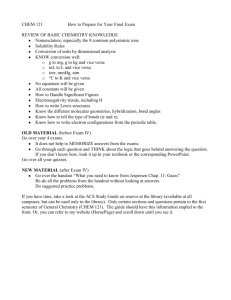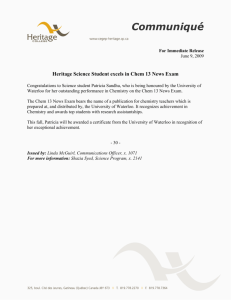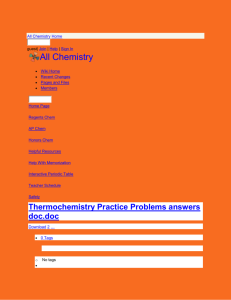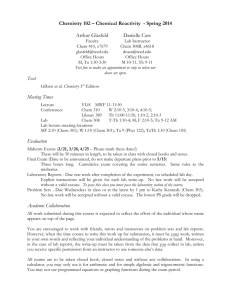Keystone Exams: Chemistry Assessment Anchors and Eligible
advertisement
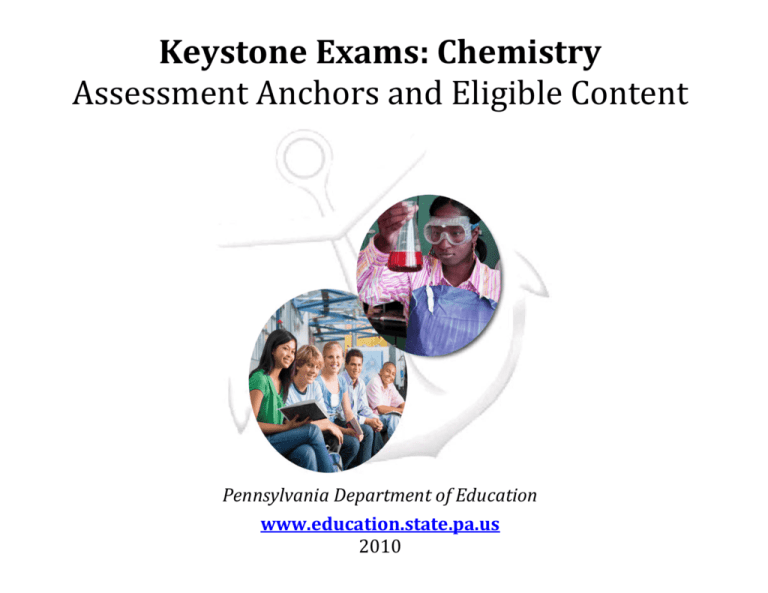
Keystone Exams: Chemistry Assessment Anchors and Eligible Content Pennsylvania Department of Education www.education.state.pa.us 2010 PENNSYLVANIA DEPARTMENT OF EDUCATION General Introduction to the Keystone Exam Assessment Anchors Introduction Since the introduction of the Keystone Exams, the Pennsylvania Department of Education (PDE) has been working to create a set of tools designed to help educators improve instructional practices and better understand the Keystone Exams. The Assessment Anchors, as defined by the Eligible Content, are one of the many tools the Department believes will better align curriculum, instruction, and assessment practices throughout the commonwealth. Without this alignment, it will not be possible to significantly improve student achievement across the Commonwealth. How were Keystone Exam Assessment Anchors developed? Prior to the development of the Assessment Anchors, multiple groups of PA educators convened to create a set of standards for each of the Keystone Exams. Enhanced standards, derived from a review of existing standards, focused on what students need to know and be able to do in order to be college and career ready. Additionally, the Assessment Anchors and Eligible Content statements were created by other groups of educators charged with the task of clarifying the standards assessed on the Keystone Exams. The Assessment Anchors, as defined by the Eligible Content, have been designed to hold together or anchor the state assessment system and curriculum/instructional practices in schools. Assessment Anchors, as defined by the Eligible Content, were created with the following design parameters: ¾ Clear: The Assessment Anchors are easy to read and are user friendly; they clearly detail which standards are assessed on the Keystone Exams. ¾ Focused: The Assessment Anchors identify a core set of standards that could be reasonably assessed on a large‐scale assessment, which will keep educators from having to guess which standards are critical. ¾ Rigorous: The Assessment Anchors support the rigor of the state standards by assessing higher‐order and reasoning skills. ¾ Manageable: The Assessment Anchors define the standards in a way that can be easily incorporated into a course to prepare students for success. How can teachers, administrators, schools, and districts use these Assessment Anchors? The Assessment Anchors, as defined by the Eligible Content, can help focus teaching and learning because they are clear, manageable, and closely aligned with the Keystone Exams. Teachers and administrators will be better informed about which standards will be assessed. The Assessment Anchors and Eligible Content should be used along with the Standards and the Curriculum Framework of the Standards Aligned System (SAS) to build curriculum, design lessons, and support student achievement. Pennsylvania Department of Education Assessment Anchors and Eligible Content Keystone Exams: Chemistry – Page 2 Final—March 1, 2010 The Assessment Anchors and Eligible Content are designed to enable educators to determine when they feel students are prepared to be successful in the Keystone Exams. An evaluation of current course offerings, through the lens of what is assessed on those particular Keystone Exams may provide an opportunity for an alignment to ensure student preparedness. How are the Assessment Anchors organized? The Assessment Anchors, as defined by the Eligible Content, are organized into cohesive blueprints, each structured with a common labeling system that can be read like an outline. This framework is organized first by module, then by Assessment Anchor, followed by Anchor Descriptor, and then finally, at the greatest level of detail, by an Eligible Content statement. The common format of this outline is followed across the Keystone Exams. Here is a description of each level in the labeling system for the Keystone Exams: ¾ Module: The Assessment Anchors are organized into two thematic modules for each of the Keystone Exams. The module title appears at the top of each page. The module level is important because the Keystone Exams are built using a module format, with each of the Keystone Exams divided into two equally‐sized test modules. Each module is made up of two or more Assessment Anchors. ¾ Assessment Anchor: The Assessment Anchor appears in the shaded bar across the top of each Assessment Anchor table. The Assessment Anchors represent categories of subject matter that anchor the content of the Keystone Exams. Each Assessment Anchor is part of a module and has one or more Anchor Descriptors unified under it. ¾ Anchor Descriptor: Below each Assessment Anchor is a specific Anchor Descriptor. The Anchor Descriptor level provides further details that delineate the scope of content covered by the Assessment Anchor. Each Anchor Descriptor is part of an Assessment Anchor and has one or more Eligible Content unified under it. ¾ Eligible Content: The column to the right of the Anchor Descriptor contains the Eligible Content statements. The Eligible Content is the most specific description of the content that is assessed on the Keystone Exams. This level is considered the assessment limit and helps educators identify the range of the content covered on the Keystone Exams. ¾ Enhanced Standard: In the column to the right of each Eligible Content statement is a code representing one or more Enhanced Standards that correlate to the Eligible Content statement. Some Eligible Content statements include annotations that indicate certain clarifications about the scope of an eligible content. o o “e.g.” (“for example”) —sample approach, but not a limit to the eligible content. “i.e.” (“that is”) —specific limit to the eligible content. What impact will the implementation of the K–12 Common Core Standards have on the content of this document? It is anticipated that there will be significant alignment between PA’s Academic Standards and the Common Core. Every effort will be made to ensure that the alignment of the standards to the Assessment Anchors and Eligible Content is maintained. As more information becomes available, PDE will inform state educators. Standards Aligned System — http://www.pdesas.org/ Pennsylvania Department of Education Assessment Anchors and Eligible Content Pennsylvania Department of Education — www.education.state.pa.us Cover photo © Hill Street Studios/Harmik Nazarian/Blend Images/Corbis. Keystone Exams: Chemistry – Page 3 Final—March 1, 2010 Keystone Exams: Chemistry MODULE A—Structure and Properties of Matter FINAL—March 1, 2010 ASSESSMENT ANCHOR CHEM.A.1 Properties and Classification of Matter Anchor Descriptor Eligible Content Enhanced Standard CHEM.A.1.1 Identify and describe how observable and measurable properties can be used to classify and describe matter and energy. CHEM.A.1.1.1 Classify physical or chemical changes within a system in terms of matter and/or energy. 3.2.C.A5 CHEM.A.1.1.2 Classify observations as qualitative and/or quantitative. 3.2.C.A2 CHEM.A.1.1.3 Utilize significant figures to communicate the uncertainty in a quantitative observation. 3.2.C.A3 CHEM.A.1.1.4 Relate the physical properties of matter to its atomic or molecular structure. 3.2.C.A2 CHEM.A.1.1.5 Apply a systematic set of rules (IUPAC) for naming compounds and writing chemical formulas (e.g., binary covalent, binary ionic, ionic compounds containing polyatomic ions). 3.2.C.A2 3.2.C.A4 Anchor Descriptor CHEM.A.1.2 Compare the properties of mixtures. Enhanced Standard Eligible Content CHEM.A.1.2.1 Compare properties of solutions containing ionic or molecular solutes (e.g., dissolving, dissociating). 3.2.C.A1 CHEM.A.1.2.2 Differentiate between homogeneous and heterogeneous mixtures (e.g., how such mixtures can be separated). 3.2.C.A1 CHEM.A.1.2.3 Describe how factors (e.g., temperature, concentration, surface area) can affect solubility. 3.2.C.A1 3.2.10.A4 CHEM.A.1.2.4 Describe various ways that concentration can be expressed and calculated (e.g., molarity, percent by mass, percent by volume). 3.2.C.A2 3.2.C.A4 3.2.10.A5 CHEM.A.1.2.5 Describe how chemical bonding can affect whether a substance dissolves in a given liquid. 3.2.12.A1 3.2.10.A2 3.2.C.A2 Eligible Content may be assessed using knowledge and/or skills associated with the Nature of Science. Pennsylvania Department of Education Assessment Anchors and Eligible Content Keystone Exams: Chemistry – Page 4 Final—March 1, 2010 Keystone Exams: Chemistry MODULE A—Structure and Properties of Matter FINAL—March 1, 2010 ASSESSMENT ANCHOR CHEM.A.2 Atomic Structure and the Periodic Table Anchor Descriptor CHEM.A.2.1 Explain how atomic theory serves as the basis for the study of matter. Anchor Descriptor CHEM.A.2.2 Describe the behavior of electrons in atoms. Enhanced Standard Eligible Content CHEM.A.2.1.1 Describe the evolution of atomic theory leading to the current model of the atom based on the works of Dalton, Thomson, Rutherford, and Bohr. 3.2.10.A1 3.2.C.A1 3.2.10.A5 3.2.C.A5 3.2.C.A2 3.2.10.A4 3.2.C.A5 CHEM.A.2.1.2 Differentiate between the mass number of an isotope and the average atomic mass of an element. 3.2.10.A1 3.2.C.A1 3.2.C.A2 Eligible Content Enhanced Standard CHEM.A.2.2.1 Predict the ground state electronic configuration and/or orbital diagram for a given atom or ion. 3.2.10.A5 3.2.C.A1 CHEM.A.2.2.2 Predict characteristics of an atom or an ion based on its location on the periodic table (e.g., number of valence electrons, potential types of bonds, reactivity). 3.2.C.A2 CHEM.A.2.2.3 Explain the relationship between the electron configuration and the atomic structure of a given atom or ion (e.g., energy levels and/or orbitals with electrons, distribution of electrons in orbitals, shapes of orbitals). 3.2.C.A2 CHEM.A.2.2.4 Relate the existence of quantized energy levels to atomic emission spectra. 3.2.12.A2 Eligible Content may be assessed using knowledge and/or skills associated with the Nature of Science. Pennsylvania Department of Education Assessment Anchors and Eligible Content Keystone Exams: Chemistry – Page 5 Final—March 1, 2010 Keystone Exams: Chemistry MODULE A—Structure and Properties of Matter Anchor Descriptor FINAL—March 1, 2010 Enhanced Standard Eligible Content CHEM.A.2.3 Explain how periodic trends CHEM.A.2.3.1 Explain how the periodicity of chemical properties led to the arrangement of elements on the periodic table. in the properties of atoms allow for the prediction of CHEM.A.2.3.2 Compare and/or predict the properties (e.g., electron affinity, ionization energy, chemical physical and chemical reactivity, electronegativity, atomic radius) of selected elements by using their locations properties. on the periodic table and known trends. 3.2.C.A2 3.2.C.A2 Eligible Content may be assessed using knowledge and/or skills associated with the Nature of Science. Pennsylvania Department of Education Assessment Anchors and Eligible Content Keystone Exams: Chemistry – Page 6 Final—March 1, 2010 Keystone Exams: Chemistry MODULE B—The Mole Concept and Chemical Interactions FINAL—March 1, 2010 ASSESSMENT ANCHOR CHEM.B.1 The Mole and Chemical Bonding Anchor Descriptor CHEM.B.1.1 Explain how the mole is a fundamental unit of chemistry. Enhanced Standard Eligible Content CHEM.B.1.1.1 Anchor Descriptor Apply the mole concept to representative particles (e.g., counting, determining mass of atoms, ions, molecules, and/or formula units). Enhanced Standard Eligible Content CHEM.B.1.2 Apply the mole concept to CHEM.B.1.2.1 Determine the empirical and molecular formulas of compounds. the composition of matter. CHEM.B.1.2.2 Apply the law of definite proportions to the classification of elements and compounds as pure substances. CHEM.B.1.2.3 Anchor Descriptor CHEM.B.1.3 Explain how atoms form chemical bonds. 3.2.C.A2 3.2.C.A4 3.2.10.A5 Relate the percent composition and mass of each element present in a compound. 3.2.C.A4 3.2.C.A1 3.2.C.A4 3.2.C.A2 3.2.C.A4 3.2.10.A5 Enhanced Standard Eligible Content CHEM.B.1.3.1 Explain how atoms combine to form compounds through ionic and covalent bonding. CHEM.B.1.3.2 Classify a bond as being polar covalent, non‐polar covalent, or ionic. CHEM.B.1.3.3 Use illustrations to predict the polarity of a molecule. 3.2.C.A2 3.2.10.A3 3.2.10.A1 3.2.C.A1 3.2.C.A1 Eligible Content may be assessed using knowledge and/or skills associated with the Nature of Science. Pennsylvania Department of Education Assessment Anchors and Eligible Content Keystone Exams: Chemistry – Page 7 Final—March 1, 2010 Keystone Exams: Chemistry MODULE B—The Mole Concept and Chemical Interactions Anchor Descriptor FINAL—March 1, 2010 Enhanced Standard Eligible Content CHEM.B.1.4 Explain how models can be CHEM.B.1.4.1 Recognize and describe different types of models that can be used to illustrate the bonds used to represent bonding. that hold atoms together in a compound (e.g., computer models, ball‐and‐stick models, graphical models, solid‐sphere models, structural formulas, skeletal formulas, Lewis dot structures). CHEM.B.1.4.2 Utilize Lewis dot structures to predict the structure and bonding in simple compounds. 3.2.12.A2 3.2.C.A1 3.2.10.A2 3.2.C.A2 Eligible Content may be assessed using knowledge and/or skills associated with the Nature of Science. Pennsylvania Department of Education Assessment Anchors and Eligible Content Keystone Exams: Chemistry – Page 8 Final—March 1, 2010 Keystone Exams: Chemistry MODULE B—The Mole Concept and Chemical Interactions FINAL—March 1, 2010 ASSESSMENT ANCHOR CHEM.B.2 Chemical Relationships and Reactions Anchor Descriptor Enhanced Standard Eligible Content CHEM.B.2.1 Predict what happens during CHEM.B.2.1.1 Describe the roles of limiting and excess reactants in chemical reactions. a chemical reaction. CHEM.B.2.1.2 Use stoichiometric relationships to calculate the amounts of reactants and products involved in a chemical reaction. CHEM.B.2.1.3 Classify reactions as synthesis, decomposition, single replacement, double replacement, or combustion. CHEM.B.2.1.4 Predict products of simple chemical reactions (e.g., synthesis, decomposition, single replacement, double replacement, combustion). CHEM.B.2.1.5 Balance chemical equations by applying the Law of Conservation of Matter. Anchor Descriptor Eligible Content 3.2.C.A4 3.2.10.A4 3.2.C.A2 3.2.C.A4 3.2.10.A5 3.2.C.A4 3.2.C.A4 3.2.C.A4 Enhanced Standard 3.2.10.A3 CHEM.B.2.2 Explain how the kinetic CHEM.B.2.2.1 Utilize mathematical relationships to predict changes in the number of particles, the 3.2.C.A3 molecular theory relates to temperature, the pressure, and the volume in a gaseous system (i.e., Boyle’s law, the behavior of gases. Charles’s law, Dalton’s law of partial pressures, the combined gas law, and the ideal gas law). CHEM.B.2.2.2 Predict the amounts of reactants and products involved in a chemical reaction using molar 3.2.10.A3 volume of a gas at STP. 3.2.C.A3 Eligible Content may be assessed using knowledge and/or skills associated with the Nature of Science. Pennsylvania Department of Education Assessment Anchors and Eligible Content Keystone Exams: Chemistry – Page 9 Final—March 1, 2010


